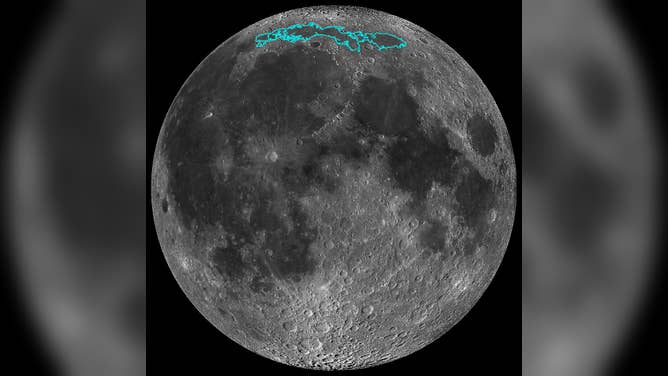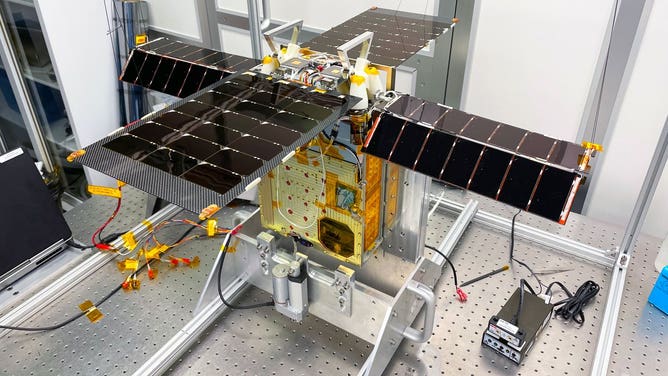SpaceX targets Sunday to launch Japanese moon lander, tiny NASA satellite in search of lunar water
The HAKUTO-R Mission 1 lunar lander from ispace will launch on a SpaceX Falcon 9 rocket from Florida on Sunday, Dec. 11 at 2:38 a.m. EST. NASA's Lunar Flashlight is also hitching a ride to the moon on this launch.

The ispace Mission 1 lunar lander integrated into the SpaceX Falcon 9 fairing. (Image: ispace/SpaceX)
Launches to the moon from Florida's coast are becoming a regular thing.
Weeks after NASA launched its Space Launch System, sending the Orion spacecraft on the Artemis 1 mission around the moon, SpaceX is preparing to launch two missions to the moon. The Falcon 9 rocket will lift off with a lander and a small NASA spacecraft, both bound for the moon.
The Japanese-led ispace HAKUTO-R Mission 1 lunar lander was scheduled to launch on Nov. 30 and Dec. 1 from Cape Canaveral Space Force Station in Florida. However, SpaceX delayed the launch to make more time to inspect the Falcon 9 rocket and review data.
According to space, the launch is now scheduled for Sunday, Dec. 11 at 2:38 a.m. EST (4:38 p.m. Japan time).
More than a week ago the lunar lander was paired with the SpaceX rocket fairing and continues to charge its batteries in preparation for liftoff. According to ispace, there is no issue with the lander.
Also onboard this launch is the Lunar Flashlight, a small satellite managed by NASA's Jet Propulsion Laboratory in California.
After launch, the SpaceX rocket booster will return for landing back at Cape Canaveral Landing Zone 1 about 8 minutes after the liftoff, sending sonic booms across Central Florida.
According to SpaceX, the launch will mark the fifth for this Falcon 9 rocket booster.
Landing in the Sea of Cold

The moon region called Mare Frigoris is outlined in this image in teal. This image is a mosaic composed of many images taken by NASA's Lunar Reconnaissance Orbiter (LRO). (Image: NASA)
(NASA)
Private company ispace began developing its lunar lander in 2010 in hopes of winning the Google Lunar XPrize. More than a decade later, ispace has offices in Japan, Luxembourg and the U.S.
While no organization ultimately won the $20 million Lunar XPrize for landing on the moon by the deadline, several companies that partook in the race were later awarded NASA contracts under the Commercial Lunar Payload Services Program, known as CLPS, including ispace.
NASA'S ORION SPACECRAFT BREAKS APOLLO DISTANCE RECORD FROM EARTH WHILE ORBITING THE MOON
The U.S. branch of ispace, working with Draper Technologies, was awarded a NASA CLPS contract to land on the far side of the moon by 2025. The company was also selected by NASA and the European Space Agency to collect lunar regolith and extract water on the moon.
As a tribute to the Google Lunar XPrize, the lander will carry a CD playing the song "SORATO" by Japanese rocket back Sakanaction, which was written in support of Team HAKUTO during the Google Lunar XPrize competition.
According to ispace, the HAKUTO-R Mission 1 will help provide data to help later contribute to NASA's Artemis program.
After launching, the HAKUTO spacecraft will orbit the moon and complete deep space navigation maneuvers to test its orbital control and navigation.
The company is targeting an April 2023 touchdown on the lunar surface near Mare Frigoris or Sea of Cold and has also selected several backup landing sites that are consistently illuminated by the sun.
A second lunar lander for Mission 2 is already in development and scheduled to launch in 2024. Under Mission 3, ispace will launch under its CLPS contract for NASA.
NASA's Lunar Flashlight in search of water

NASA’s Lunar Flashlight mission undergoing tests to prepare it for launch in November 2022. (Image Credit: NASA/JPL-Caltech)
(NASA)
Hitching a ride to the moon with SpaceX is a small NASA satellite called the Lunar Flashlight. About the size of a briefcase, the so-called SmallSat will search the permanently shadowed regions of the lunar South Pole for water.
Using a reflectometer, the Lunar Flashlight will beam lasers at rocks or regolith that will reflect back to the spacecraft. NASA said that if the light is absorbed by the surface, it indicates the presence of ice.
NASA'S SPACECRAFT ARRIVES, TESTING OUT SPECIAL LUNAR ORBIT FOR FUTURE HUMAN MISSIONS
"We are bringing a literal flashlight to the moon – shining lasers into these dark craters to look for definitive signs of water ice covering the upper layer of lunar regolith," said Barbara Cohen, Lunar Flashlight principal investigator at NASA’s Goddard Space Flight Center. "I’m excited to see our mission contribute to our scientific understanding of where water ice is on the moon and how it got to be there."
The Lunar Flashlight's lunar orbit will be a near-rectilinear halo orbit, only achieved recently in November by NASA's CAPSTONE spacecraft. The Flashlight will zoom 43,000 miles away from the moon at its farthest point and get as close as 9 miles above the surface of the lunar South Pole.
NASA and its international partners hope to eventually mine the water found on the moon for fuel and other resources.